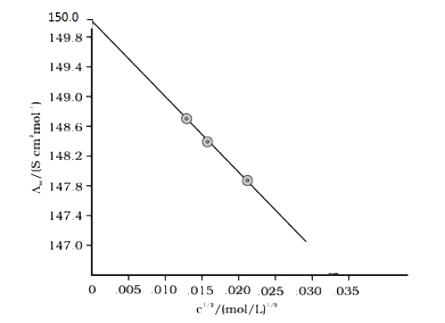The standard reduction potential E∘ of the following systems are:-
SystemE∘(volts)(i)MnO−4+8H++5e−→Mn2++4H2O1.51(ii)Sn4++2e−→Sn2+0.15(iii)Cr2O2−7+14H++6e−→2Cr3++7H2O1.33(iv)Ce4++e−→Ce3+1.61
The oxidising power of teh various species decreases in the order
The correct Answer is:B
Step by step video, text & image solution for The standard reduction potential E^(@) of the following systems are:- {:(System,E^(@)("volts")),((i)MnO_(4)^(-)+8H^(+)+5e^(-)rarrMn^(2+)+4H_(2)O,1.51),((ii)Sn^(4+)+2e^(-)rarrSn^(2+)0.15,),((iii)Cr_(2)O_(7)^(2-)+14H^(+)+6e^(-)rarr2Cr^(3+)+7H_(2)O,1.33),((iv)Ce^(4+)+e^(-)rarrCe^(3+)1.61,):} The oxidising power of teh various species decreases in the order by Chemistry experts to help you in doubts & scoring excellent marks in Class 12 exams.
Topper's Solved these Questions
- BOOK - RESONANCECHAPTER - ELECTROCHEMISRYEXERCISE - Comprehension31videos
ELECTROCHEMISRY
- BOOK - RESONANCECHAPTER - ELECTROCHEMISRYEXERCISE - Exercise 37videos
ELECTROCHEMISRY
- BOOK - RESONANCECHAPTER - ELECTROCHEMISRYEXERCISE - Subjective Questions14videos
ELECTROCHEMISRY
- BOOK - RESONANCECHAPTER - ELECTRO CHEMISTRYEXERCISE - PHYSICAL CHEMITRY (ELECTROCHEMISTRY)53videos
ELECTRO CHEMISTRY
- BOOK - RESONANCECHAPTER - EQUIVALENT CONCEPT & TITRATIONSEXERCISE - Part -IV22videos
EQUIVALENT CONCEPT & TITRATIONS
Similar Questions
Standard electrode potentials of few half-cell reactions are given below :
MnO−4+8H++5e−→Mn2++4H2OE∘=1.51VCr2O2−7+14H++6e−→2Cr3++7H2OE∘=1.33VFe3++e−→Fe2+E∘=0.77VCl2+2e−→2Cl−E∘=1.36
Based on the above information match the column I with column II and mark the appropriate choice.
 View Solution
View SolutionOn the basis of Eo values identify which amongst the following is the strongest oxidising agent
Cl2(g)+2e−→2Cl−E∘=+1.36V,
MnO−4+8H++5e−→Mn2++4H2OE∘=+1.51V
Cr2O2−7+14H++6e−→2Cr3++7H2OE∘=+1.33V
(ii) The following figure 2, represents variation of (Λm) vs √c for an electrolyte. Here Λm is the molar conductivity and c is the concentration of the electrolyte.

a) Define molar conductivity
b) Identify the nature of electrolyte on the basis of the above plot. Justify your answer.
c) Determine the value of Λmo for the electrolyte.
d) Show how to calculate the value of A for the electrolyte using the above graph.View Solution
Knowledge Check
- Question 1 - Select One
The standard redox potentials E∘ of the following systems are SystemE∘(volts)(i)MnO−4+BH++5e−→Mn2++4H2O1.51(ii)Sr2+→Sn4++2e−−0.15(iii)Cr2O2−7+14H++6e−1.33(iv)Ce3+→Ce4++e−−1.61
The oxidising power of the various species are related asACr2O2−7>MnO−4BCe4+>Sn4+CCe4+>MnO4DMnO_4^(-) gt Sn^(4+) - Question 2 - Select One
For reaction :
Cr2O−27+14H+→2Cr+3+7H2O, How many e−s are requiredA3B4C5D6 - Question 3 - Select One
MnO−4+8H++5e−→Mn2++4H2O, E∘=1.51V
MnO2+4H++2e−rig↔owMn2++2H2O E∘=1.23V
EMnO−4∣MnO2A1.70VB0.91VC1.37vD0.548V
For the reactions
MnO−4+8H++5e−→Mn2+4H2O,Eo=+1.51VMnO2+4H++2e−→Mn2++2H2O,Eo=+1.23V
then for the reaction :
MnO−4+4H++3e−→MnO2+2H2O,EoView SolutionStandard electrode potential data are useful for understanding the suitability of an oxidant in a redox titration. Some half cell reaction and their standard potentials are given below:
MnO−4(aq)+8H+(aq)+5e−→Mn2+(aq)+4H2O(l)E∘=1.51V
Cr2O2−7(aq)+14H+(aq)+6e−→2Cr3+(aq)+7H2O(l),E∘=1.38V
Fe3+(aq)+e−→Fe2+(aq),E∘=0.77V
CI2(g)+2e−→2CI−(aq),E∘=1.40V
Identify the only incorrect statement regarding quantitative estimation of aqueous Fe(NO3)2View SolutionUse the given standard reduction potentials to determine the reduction potential for this half-reactions.
MnO−4(aq)+3e−+4H+→MnO2(S)+2H2O(l)
 View Solution
View SolutionFor Cr2O27+14H++6e−→2Cr3++7H2O
E∘=1.33V.At298k,[Cr2O2−7]=4.5 millimole
[Cr3+]=15 millimole ,E is 1.067 v The pH of the solution is nearly eual toView SolutionStandard electrode potential data are useful for understanding the suitability of an oxidant in a redox titration some half cell reactions and their standard potentials are given below
MnO−4(aq)+8H+(aq)+5e−→Mn2+(Aq)+4H2O(l)∘=1.51V
Cr2O2−7(Aq)+14H+(aq)+6e−→2cr3+(aq)+7H2O(l),E2=1.38V
CI2(g)+2e−→2CI−(aq),E∘=1.40V
Identify the incorrect statement regarding the qunatitavite estimation of gaseous Fe(NO3)2View Solution

